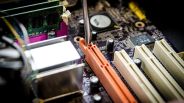Peanut butter and chocolate. Pam and Jim from The Office. Christmas and presents. We've seen many great combinations throughout history, and we now have one more to add to the list. Researchers at The Ohio State University have invented the world's first solar battery.
The researchers report that they have been able to combine a battery and a solar cell into one device. Their findings were published in the Oct. 3, 2014 issue of the journal Nature Communications.
The battery includes a mesh solar panel that allows air to enter. Then, a special process takes place where electrons are transferred between the solar panel and the battery's electrode. The battery uses light and oxygen to charge.
ⓒ 2025 TECHTIMES.com All rights reserved. Do not reproduce without permission.




